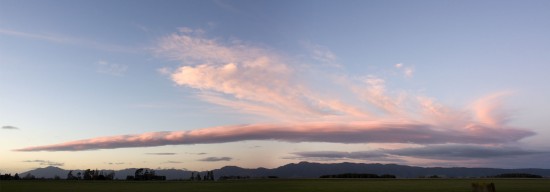Saturday, 23rd May at Matamata started with fog and a -1 degree temperature. The fog lifted suddenly about 12.30 and as I had some maintenance to attend to on our self launching glider, GUL, I headed out to the airfield.
On arrival, the windsock was showing a light southerly and the Club were in the process of changing ends from 28 to 10. After changing the spark plug caps on the Rotax, naturally I decided that the developing convection needed investigation.
By the time I was set for take off, there was a light SW wind on the ground and so I decided to head for the ridge to join with Nelson in IY, who was reporting he had no problem maintaining 4000 feet in the ridge assisted thermals. After arriving at the ridge at 2500 feet, I shut down the iron thermal and did find that the hazy cu’s above the ridge were giving 4~6 knot climbs.
After climbing to 4000 feet, I headed north from the high point across Thompson’s Track towards Te Aroha, as I have done hundreds of times before. However, the prospects did not look particularly encouraging, with the next line of convection north of Te Aroha and no support from the ridge, I turned back to head south at about 3500 feet.
As I approached the high point side of Thompson’s track, I ran into some of the worst turbulence I have ever experienced, coupled with 19 knots of sink. My only option was to increase my airspeed to Vra, 86 knots, and turn away from the rapidly approaching side of the ridge. There was a brief respite as the sink reduced to 4 knots and then heavier sink coupled with an uncommanded roll to the left towards the valley side. Despite full opposite control deflections against the roll, UL got to about 70 degrees of bank before responding to my control inputs. By this time, I was about half way out of the Thompson’s track valley in strong sink, struggling to maintain approximately 70 knots in the turbulence and with the very strong illusion of descending rapidly without making any forward progress. At this stage, I was down to about 2000 feet and very seriously looking for somewhere to land close to the foot of the ridge. Erecting the motor was considered, but rejected as it would have cost me even more height and would not have had enough power to overcome the ongoing 10~12 knot sink.
At 1600 feet things quietened down a bit and I had sufficient terrain clearance to turn left onto the slopes on the southern side of the high point, hoping that I would get some assistance from the ridge. I was hugely relieved to find that the ridge was working at 2~4 knots and I climbed back up while getting my heart rate under control and the seat extracted from my nether regions!
So, what happened? I can only make some semi-educated guesses. There were two reports on the radio chatter of the wind being 27 knots at 180 at 3000 feet and there were also a number of lenticulars on the Waikato side of the Kamais, nothing I could see on the Tauranga side, though. So, I think what I ran into was a combination of a southerly curl-over from the side of the high point, coupled with a rotor from one of the wave systems.
What did I learn from this “adventure?” 1. Not to take the ridge for granted. This is the second time in 30 odd years and 2500 hours of gliding that I have been shot down by wave interaction with the ridge. The previous incident, I ended up in the Te Aroha race course in GIY after solid ridge lift on Mt Te Aroha turned into 10 knots down, right down to the ground. 2. Always have an escape path in mind: It’s hard to make a mental gear change to accept that an area which has always provided lift in the past is now doing something completely different. 3. Don’t fly too close to the ridge. The uncommanded turn to the left may well have resulted in contact with the terrain if I had been a bit closer to the side of the ridge. 4. Safe airspeed near the ground! Even at max rough air speed, I was making very little progress into the wind and just sinking like a stone. At lower airspeeds, the control response is slower and with turbulence, high angles of bank and large control inputs, it may well have resulted in a stall/spin situation. Additionally of course is the classic “fly faster in sink” response, which contributed to the extraordinary feeling of just descending, highlighted by being in close proximity to the ridge and of almost standing still over the ground.
Finally, I will pay more attention to the possibility of an out of phase wave system dumping on the windward side of the ridge, especially when there are lenticulars on the upwind side of the valley.
Julian Mason
PGC

